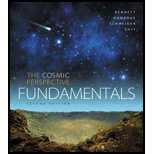
Concept explainers
Choose the best answer to each of the following. Explain your reasoning.
What shows down the contraction of a star-forming cloud when it makes a protostar? (a) production of fusion energy (b) magnetic fields (c) trapping of thermal energy inside the protostar.
The correct option for the cause that slows down the contraction of a star-forming cloud when it makes a protostar.
Answer to Problem 1QQ
Option (c) is the correct answer. Trapping of thermal energy inside the protostar slows down the contraction of a star-forming cloud.
Explanation of Solution
Introduction:
Protostar is a contracted mass of gases and it represents the early stage in the formation of a star. This phase starts when a fragment of cloud collapses under the gravitational forces and ends when a pre-main-sequence star is formed due to the depletion of in falling gas. This pre-main-sequence star later forms a main-sequence star.
During the formation of protostar, the thermal energy gets trapped inside the protostar. Also, the gravity results in the contraction of the protostar due to inward force. But the increase in thermal energy results in an increase of thermal pressure, which pushes the layers outward. Hence, contraction of star-forming cloud slows down.
Thus, option (c) is correct.
Option (a) is incorrect as no fusion energy is produced during the formation of protostar.
Option (b) is incorrect as there is reduction in magnetic fields.
Conclusion:
Hence, trapping of thermal energy inside the protostar slows down the contraction of a star-forming cloud when it makes a protostar.
Want to see more full solutions like this?
Chapter 9 Solutions
The Cosmic Perspective Fundamentals (2nd Edition)
Additional Science Textbook Solutions
Concepts of Genetics (12th Edition)
Chemistry: An Introduction to General, Organic, and Biological Chemistry (13th Edition)
Organic Chemistry (8th Edition)
Genetic Analysis: An Integrated Approach (3rd Edition)
Microbiology: An Introduction
Anatomy & Physiology (6th Edition)
- pls help on all asked questions kindlyarrow_forward19. Mount Everest, Earth's highest mountain above sea level, has a peak of 8849 m above sea level. Assume that sea level defines the height of Earth's surface. (re = 6.38 × 106 m, ME = 5.98 × 1024 kg, G = 6.67 × 10 -11 Nm²/kg²) a. Calculate the strength of Earth's gravitational field at a point at the peak of Mount Everest. b. What is the ratio of the strength of Earth's gravitational field at a point 644416m below the surface of the Earth to a point at the top of Mount Everest? C. A tourist watching the sunrise on top of Mount Everest observes a satellite orbiting Earth at an altitude 3580 km above his position. Determine the speed of the satellite.arrow_forwardpls help on allarrow_forward
- pls help on allarrow_forward6. As the distance between two charges decreases, the magnitude of the electric potential energy of the two-charge system: a) Always increases b) Always decreases c) Increases if the charges have the same sign, decreases if they have the opposite signs d) Increases if the charges have the opposite sign, decreases if they have the same sign 7. To analyze the motion of an elastic collision between two charged particles we use conservation of & a) Energy, Velocity b) Momentum, Force c) Mass, Momentum d) Energy, Momentum e) Kinetic Energy, Potential Energyarrow_forwardpls help on all asked questions kindlyarrow_forward
- pls help on all asked questions kindlyarrow_forward17. Two charges, one of charge +2.5 × 10-5 C and the other of charge +3.7 × 10-6 C, are 25.0 cm apart. The +2.5 × 10−5 C charge is to the left of the +3.7 × 10−6 C charge. a. Draw a diagram showing the point charges and label a point Y that is 20.0 cm to the left of the +3.7 × 10-6 C charge, on the line connecting the charges. (Field lines do not need to be drawn.) b. Calculate the net electric field at point Y.arrow_forward3arrow_forward

 AstronomyPhysicsISBN:9781938168284Author:Andrew Fraknoi; David Morrison; Sidney C. WolffPublisher:OpenStax
AstronomyPhysicsISBN:9781938168284Author:Andrew Fraknoi; David Morrison; Sidney C. WolffPublisher:OpenStax Horizons: Exploring the Universe (MindTap Course ...PhysicsISBN:9781305960961Author:Michael A. Seeds, Dana BackmanPublisher:Cengage Learning
Horizons: Exploring the Universe (MindTap Course ...PhysicsISBN:9781305960961Author:Michael A. Seeds, Dana BackmanPublisher:Cengage Learning Foundations of Astronomy (MindTap Course List)PhysicsISBN:9781337399920Author:Michael A. Seeds, Dana BackmanPublisher:Cengage Learning
Foundations of Astronomy (MindTap Course List)PhysicsISBN:9781337399920Author:Michael A. Seeds, Dana BackmanPublisher:Cengage Learning Stars and Galaxies (MindTap Course List)PhysicsISBN:9781337399944Author:Michael A. SeedsPublisher:Cengage Learning
Stars and Galaxies (MindTap Course List)PhysicsISBN:9781337399944Author:Michael A. SeedsPublisher:Cengage Learning Stars and GalaxiesPhysicsISBN:9781305120785Author:Michael A. Seeds, Dana BackmanPublisher:Cengage Learning
Stars and GalaxiesPhysicsISBN:9781305120785Author:Michael A. Seeds, Dana BackmanPublisher:Cengage Learning





